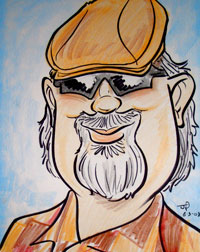
My two favorite days were Thursday and Sunday. Thursday is not an official day but it’s the day everyone is trying to finish up to be ready for all the people who will be showing up Friday. I love the hustle and bustle of setup day. This year people seemed to be further along than years before which meant they had more time to visit, which was very nice. I am always amazed how good some people can get hotel rooms to sound with so little time to set them up.
Now, Sunday was my favorite day for a totally different reason. At most audio shows Sunday is the poorest attended day. Now listen to me, if I have any advice about going to shows; it’s don’t miss Sunday. Without exception, every room I went back to on Sunday was sounding much better. Not only that, everybody was more relaxed and easier to talk to. I really enjoyed Sunday in a way I’m not used to enjoying audio shows.
I noticed a few trends at the 2011 RMAF, some predictable and one just strange. The predictable one was the lack of CD/SACD players and transports. Even in rooms with very good players they were being used with a computer audio source in most cases. Some of the computer audio systems, especially those playing hi-res files really sounded great, a hard thing for this old beatnik to admit.
One of the most interesting demonstrations of computer based audio was off campus at Aaudio Imports’ headquarters. Brian Ackerman had invited a group over and provided even a nice tour style bus to takes us over there. There, Carlos Candeias, owner, managing director, and founder of B.M.C. Audio gave an educational demonstration and lecture about the advance in digital sound that covered both computer software and hardware. One of the most interesting things to me was when the demonstration was over and we were going to just listen to music for a while, he asked if we wanted to listen to music from the computer or the transport. I was shocked that it was about 50/50 to which source. I thought in the demonstration the computer based system had sounded much less digital, but I got the feeling that some people just can’t let go of having a physical medium they can hold in their hands and play.
The other trend that did surprise me was how many reel-to-reel tape decks were being used. I have to admit that every one I listened to sounded great, especially with “The Tape Project” tapes. The problem is there are less than thirty of these available and they cost $300 per album; even if you chose to go the way that Kara had in the deHavilland room where she was playing old commercial prerecorded tapes. You can pick the tapes up used on eBay. She played them on her rebuilt Ampex and her deHavilland 222 Vacuum Tube Magnetic Tape Playback Preamplifier. These sounded really good as well, but I still don’t understand the trend toward reel-to-reel. There is so little software to play on them, and talk about inconvenience; I don’t know a single other medium that is as fussy. The way I remember it from when I owned a Tandberg and a Revox, heads wore out quickly, tapes break, it’s almost impossible to move to the selection you want to play, and then the big one, all the time it takes to rewind the tapes. Yes, they are fun at shows, but this old beatnik won’t have one anytime soon.
Of course the best thing about any audio show is the time you get to spend with old and new friends. Here are a few pictures of those I enjoyed visiting with. There are some I did not get pictures, but I thought you might enjoy these:
I always enjoy hanging out with Mike Zivkovic in the Teresonic room. This year I had the privilege to meet on of his partners Miles Dabic. They went to high school, college, and graduated in acoustical engineering together. They even went to music school together. I’m sure this has something to do with how musical their speakers sound like.
Next door was the deHavilland room with Kara.
It’s always so much fun to visit with Peter Ledermann of Soundsmith.
Brian Ackerman of Aaudio Imports is always a great host. This year, he introduced me to two new friends.
Second picture of Brian.
Acapella Audio Art’s Hermann Winters.
Carlos Candeias, owner and founder of B.M.C. Audio.
Ray Kimber of Kimber Kable always has great sound and my favorite thing about Ray is that after all these years he still sell PBJ interconnects.
Picture of the PBJ interconnects
- (Page 1 of 2)
- Next page →









